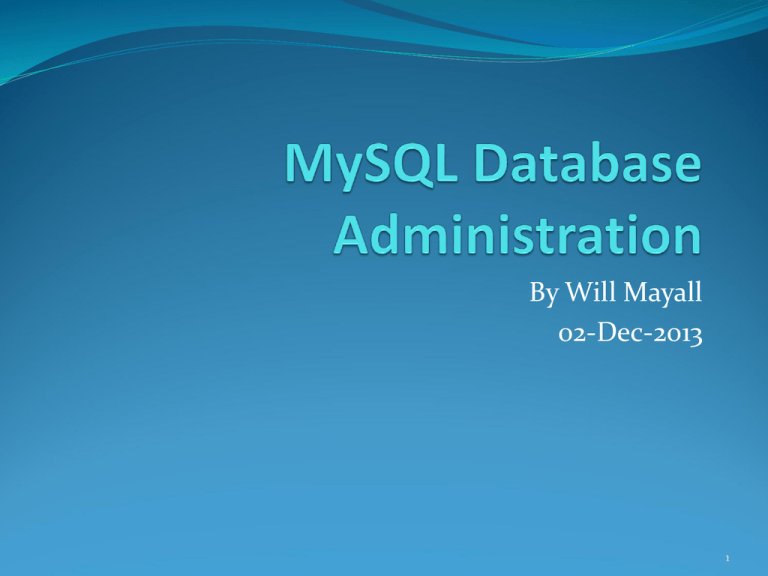MySQL Database Administration
advertisement

By Will Mayall 02-Dec-2013 1 Filesystem Check The first thing you need to know is that /var/lib/mysql/ibdata1 file NEVER shrinks! We opted to enable innodb_file_per_table to bypass ibdata1 file from growing out of control. However, the individual *.ibd files will grow, the optimize command will shrink the file, but will lock the table! ls –ltr /apps/mysql_data/ > LS_MYSQL_02dec2013.doc Also keep track of all the filesystems. df –h > DF_H_02dec2013.doc 2 Check Database Sizes Check the size of the databases daily. tee DATABASE_SIZES.doc select sysdate(); SELECT table_schema "Data Base Name",sum( data_length + index_length ) / 1024 / 1024 "Data Base Size in MB",sum( data_free )/ 1024 / 1024 "Free Space in MB" FROM information_schema.TABLES GROUP BY table_schema; 3 Verify Database Sizes 02-Dec-2013 Data Base Name Data Base Size in MB Free Space in MB MY_DB 7770.32812500 7.00000000 performance_schema 0.00000000 0.00000000 information_schema 0.00781250 0.00000000 mysql 0.77073860 0.09775925 4 Check the Number of Users It’s a good idea to know your users as you are their client. Therefore, get a daily count of users and compare it from the pervious day. Make a note of new users. 03-Dec-2013 QUERY select count(*) from mysql.user; COUNT 21 5 Check the Growth of Tables It’s a bad idea to do select count(*) of tables, but since this is a new application, knowing the table growth rate out weighs the performance hit. mysqlshow -uUSER -p -t radius --count 6 Check the Global Status During peak traffic, checking the global status can help identify variables that are being exceeded. echo "show global status\G" | mysql -uUSER -p 7 Check the Global Variables It is good to verify the variables in the my.cnf actually were picked up. echo "show global variables;" | mysql -uUSER -p 8 Show engine innodb status For innodb tables, getting a 60 second snapshot of the status can help identify problems. mysql> show engine innodb status\Gselect sleep(60); show engine innodb status\G *************************** 1. row *************************** Type: InnoDB Name: Status: ===================================== 131206 21:04:28 INNODB MONITOR OUTPUT ===================================== Per second averages calculated from the last 27 seconds ----------------BACKGROUND THREAD ----------------srv_master_thread loops: 47785 1_second, 47438 sleeps, 4253 10_second, 17623 background, 17623 flush srv_master_thread log flush and writes: 50244 ---------- 9 Database Table Status MySQL gathers Metadata about the status of the Tables. mysql> show table status from radius\G *************************** 4. row *************************** Name: radcheck Engine: InnoDB Version: 10 Row_format: Compact Rows: 1 Avg_row_length: 16384 Data_length: 16384 Max_data_length: 0 Index_length: 16384 Data_free: 0 Auto_increment: 2 Create_time: 2013-11-17 01:30:32 Update_time: NULL Check_time: NULL Collation: latin1_swedish_ci Checksum: NULL Create_options: Comment: 10 Database Index Status MySQL gathers Metadata about the status of the Tables. mysql> show index from radius.radacct\G *************************** 1. row *************************** Table: radacct Non_unique: 0 Key_name: PRIMARY Seq_in_index: 1 Column_name: radacctid Collation: A Cardinality: 15293918 Sub_part: NULL Packed: NULL Null: Index_type: BTREE Comment: Index_comment: 11 Identifying Indexes To check Indexes mysql> show create table radacct\G *************************** 1. row *************************** Table: radacct Create Table: CREATE TABLE `radacct` ( `radacctid` bigint(21) NOT NULL AUTO_INCREMENT, `acctsessionid` varchar(64) NOT NULL DEFAULT '', `acctuniqueid` varchar(32) NOT NULL DEFAULT '', `username` varchar(64) NOT NULL DEFAULT '', `groupname` varchar(64) NOT NULL DEFAULT '', `realm` varchar(64) DEFAULT '', `nasipaddress` varchar(15) NOT NULL DEFAULT '', `nasportid` varchar(15) DEFAULT NULL, `nasporttype` varchar(32) DEFAULT NULL, `acctstarttime` datetime DEFAULT NULL, `acctstoptime` datetime DEFAULT NULL, `acctsessiontime` int(12) DEFAULT NULL, `acctauthentic` varchar(32) DEFAULT NULL, `connectinfo_start` varchar(50) DEFAULT NULL, `connectinfo_stop` varchar(50) DEFAULT NULL, `acctinputoctets` bigint(20) DEFAULT NULL, `acctoutputoctets` bigint(20) DEFAULT NULL, `calledstationid` varchar(50) NOT NULL DEFAULT '', `callingstationid` varchar(50) NOT NULL DEFAULT '', `acctterminatecause` varchar(32) NOT NULL DEFAULT '', `servicetype` varchar(32) DEFAULT NULL, `framedprotocol` varchar(32) DEFAULT NULL, `framedipaddress` varchar(15) NOT NULL DEFAULT '', `acctstartdelay` int(12) DEFAULT NULL, `acctstopdelay` int(12) DEFAULT NULL, `xascendsessionsvrkey` varchar(10) DEFAULT NULL, PRIMARY KEY (`radacctid`), UNIQUE KEY `acctuniqueid` (`acctuniqueid`), KEY `username` (`username`), KEY `framedipaddress` (`framedipaddress`), KEY `acctsessionid` (`acctsessionid`), KEY `acctsessiontime` (`acctsessiontime`), KEY `acctstarttime` (`acctstarttime`), 12 Understanding Queries mysql> select nasipaddress,count(username),count(distinct username) from radacct group by nasipaddress; +---------------+-----------------+--------------------------+ | nasipaddress | count(username) | count(distinct username) | +---------------+-----------------+--------------------------+ | 10.1.0.10 | 6045699 | 126297 | | 10.1.1.10 | 5778471 | 117264 | | 10.1.2.10 | 1075127 | 65160 | | 10.1.3.10 | 5187412 | 93745 | | 10.1.4.10 | 4726818 | 107447 | +---------------+-----------------+--------------------------+ 5 rows in set (38.00 sec) mysql> explain select nasipaddress,count(username),count(distinct username) from radacct group by nasipaddress; +----+-------------+---------+-------+---------------+--------------+---------+------+----------+-------+ | id | select_type | table | type | possible_keys | key | key_len | ref | rows | Extra | +----+-------------+---------+-------+---------------+--------------+---------+------+----------+-------+ | 1 | SIMPLE | radacct | index | NULL | nasipaddress | 17 | NULL | 15294970 | NULL | +----+-------------+---------+-------+---------------+--------------+---------+------+----------+-------+ 1 row in set (0.00 sec) mysql> 13 Forcing Indexes You can force MySQL to use an Index and get a different Explain Plan. mysql> explain select nasipaddress,count(username),count(distinct username) from radacct use index (nasipaddress) group by nasipaddress; +----+-------------+---------+-------+---------------+--------------+---------+------+----------+-------+ | id | select_type | table | type | possible_keys | key | key_len | ref | rows | Extra | +----+-------------+---------+-------+---------------+--------------+---------+------+----------+-------+ | 1 | SIMPLE | radacct | index | NULL | nasipaddress | 17 | NULL | 15295535 | NULL | +----+-------------+---------+-------+---------------+--------------+---------+------+----------+-------+ 1 row in set (0.00 sec) mysql> 14 Profiling a Query mysql> set profiling=1; Query OK, 0 rows affected, 1 warning (0.00 sec) mysql> select nasipaddress,count(username),count(distinct username) from radacct group by nasipaddress; +---------------+-----------------+--------------------------+ | nasipaddress | count(username) | count(distinct username) | +---------------+-----------------+--------------------------+ | 10.1.0.10 | 6046041 | 126298 | | 10.1.1.10 | 5778779 | 117265 | | 10.1.2.10 | 1075229 | 65161 | | 10.1.3.10 | 5187580 | 93745 | | 10.1.4.10 | 4727107 | 107447 | +---------------+-----------------+--------------------------+ 5 rows in set (37.91 sec) 15 Profiling a Query Continued mysql> show profile for query 1; +----------------------+-----------+ | Status | Duration | +----------------------+-----------+ | starting | 0.000054 | | checking permissions | 0.000007 | | Opening tables | 0.000011 | | init | 0.000014 | | System lock | 0.000008 | | optimizing | 0.000007 | | statistics | 0.000019 | | preparing | 0.000047 | | Sorting result | 0.000005 | | executing | 0.000004 | | Sending data | 37.915050 | | end | 0.000439 | | removing tmp table | 0.000013 | | end | 0.000007 | | query end | 0.000011 | | closing tables | 0.000016 | | freeing items | 0.000027 | | logging slow query | 0.000006 | | cleaning up | 0.000015 | +----------------------+-----------+ 19 rows in set, 1 warning (0.00 sec) mysql> 16 Checking Replication mysql> show slave status\G *************************** 1. Slave_IO_State: Master_Host: Master_User: Master_Port: Connect_Retry: Master_Log_File: Read_Master_Log_Pos: Relay_Log_File: Relay_Log_Pos: Relay_Master_Log_File: Slave_IO_Running: Slave_SQL_Running: Replicate_Do_DB: Replicate_Ignore_DB: Replicate_Do_Table: Replicate_Ignore_Table: Replicate_Wild_Do_Table: Replicate_Wild_Ignore_Table: Last_Errno: Last_Error: Skip_Counter: Exec_Master_Log_Pos: Relay_Log_Space: Until_Condition: Until_Log_File: Until_Log_Pos: Master_SSL_Allowed: Master_SSL_CA_File: Master_SSL_CA_Path: Master_SSL_Cert: Master_SSL_Cipher: Master_SSL_Key: Seconds_Behind_Master: Master_SSL_Verify_Server_Cert: Last_IO_Errno: row *************************** Queueing master event to the relay log mysql01-db repl 3307 60 blog.022416 861798108 mysql02-relay-bin.002375 55290803 blog.022416 Yes Yes 0 0 861797661 189530366 None 0 No 0 No 0 17 Repairing Replication If Replication Breaks, you MIGHT be able to by-pass the error, otherwise you will have to rebuild Replication from the Master. mysql>SET GLOBAL sql_slave_skip_counter = 1; mysql>start slave; mysql>show slave status\G 18 Helpful Unix Commands Get to know your filesystem (/etc/fstab), eg. ext3 vs ext4. fs_spec- desc FS, fs_file – desc mount point, fs_vfstype – desc the type of FS, fs_mntops – desc mount option, fs_freq – desc determines FS dump, fs_passno – used by fsck To increase I/O performance change the fs_mntops from the defaults. /dev/mapper/osvg-root / ext4 UUID=c96df9ac-787b-4388-9de9-74c292692f9b /boot /dev/mapper/osvg-opt /opt ext4 /dev/mapper/osvg-var /var ext4 /dev/mapper/appsvg-apps /apps ext4 /dev/sda2 /apps/full_backup ext4 tmpfs /dev/shm tmpfs devpts /dev/pts devpts sysfs /sys sysfs proc /proc proc LABEL=swap swap swap defaults ext3 defaults defaults defaults defaults defaults gid=5,mode=620 defaults defaults defaults 1 1 defaults 1 2 1 2 1 2 1 2 0 0 0 0 0 0 0 0 0 0 1 2 19 ext3 vs ext4 ext3 Introduced in 2001 ext3 supports journaling which improves speed. There are three levels of journaling for ext3 ” lowest, medium, highest ” risk check. ext4 With the stable release of ext4 in 2008, this becomes one of the best file system out there. Transferring speed is really good, but it’s not depending on the file system itself, it also relies on hardware specifications, operating system, Kernel and many more dependencies. 20 ext3 vs ext4 Ext3 ext4 Stands For Third Extended Filesystem Fourth Extended Filesystem Original OS Linux Linux Max Volume Size 256TB 1 EB Max File Size 16GB – 2TB 16TB Max Filename Length 254 bytes 256 bytes Journaling Yes Yes 21 IOSTAT -dx iostat –dx 2 20 Device: sda dm-0 dm-1 dm-2 dm-3 dm-4 dm-5 dm-6 dm-7 dm-8 dm-9 sdf sdg sdh sdi dm-10 dm-11 dm-12 dm-13 sdb sdc sdd sde rrqm/s 0.00 0.01 0.00 0.01 0.00 0.00 0.00 0.00 0.00 0.00 0.00 0.00 0.00 0.00 0.00 0.00 0.00 0.00 0.00 0.00 0.00 0.00 0.00 wrqm/s 0.01 83.08 0.00 14.16 0.00 0.00 0.00 0.00 0.00 0.00 0.00 0.00 0.00 0.00 0.00 0.00 0.00 0.00 0.00 0.00 0.00 0.00 0.00 r/s 0.05 0.03 0.01 0.05 0.01 0.01 0.02 0.00 0.05 0.01 0.03 0.03 0.01 0.01 0.01 0.00 0.01 0.01 0.01 0.00 0.00 0.00 0.00 w/s 0.04 24.24 0.00 4.13 0.00 0.00 107.32 0.00 18.29 0.00 1.29 2.20 0.00 14.27 0.00 0.00 16.55 0.18 103.01 1.03 0.00 6.67 0.00 rsec/s 28.98 2.22 0.05 2.20 0.01 0.51 2.19 0.02 2.16 0.49 1.20 1.12 0.26 1.13 0.05 0.48 0.50 0.40 2.14 0.03 0.01 0.01 0.01 wsec/s avgrq-sz avgqu-sz 27.89 668.00 0.00 819.96 33.88 0.03 0.00 4.06 0.00 144.24 35.01 0.08 0.00 1.21 0.00 0.00 35.39 0.00 819.96 7.66 0.19 0.00 5.35 0.00 144.24 7.98 0.43 0.00 40.33 0.00 10.36 8.76 0.04 72.19 32.97 0.01 0.00 33.39 0.00 410.12 28.78 0.01 0.00 5.44 0.00 0.00 99.96 0.00 132.43 8.03 0.38 1.46 9.77 0.00 819.95 7.98 0.19 30.27 29.41 0.00 0.00 4.85 0.00 192.74 28.89 0.01 0.00 8.00 0.00 await 1.71 1.36 24.57 18.36 5.21 4.39 1.75 6.55 23.40 4.52 31.10 3.59 3.74 0.98 1.72 7.45 23.24 17.27 1.82 3.86 3.57 0.84 1.66 svctm 0.65 0.90 24.56 1.75 1.74 4.02 0.20 3.70 0.40 3.53 1.46 0.56 3.74 0.71 1.72 5.03 0.37 8.02 0.21 0.48 3.57 0.61 1.66 %util 0.01 2.18 0.03 0.73 0.00 0.01 2.17 0.00 0.73 0.00 0.19 0.12 0.00 1.02 0.00 0.00 0.62 0.15 2.17 0.05 0.00 0.40 0.00 22 VMSTAT vmstat 2 20 procs -----------memory---------- ---swap-- -----io---- --system-- -----cpu----r b swpd free buff cache si so bi bo in cs us sy id wa st 2 0 0 147798752 741408 101980384 0 0 1 16 0 0 0 0 99 0 0 0 0 0 147799344 741408 101980400 0 0 0 626 478 1977 0 0 100 0 0 0 0 0 147798640 741408 101980400 0 0 0 76 306 218 0 0 100 0 0 1 0 0 147799040 741408 101980400 0 0 0 0 145 185 0 0 100 0 0 23 TOP You need to know MySQL pre-allocates Memory at startup. top top - 22:03:56 up 69 days, 20:02, 1 user, load average: 0.34, 0.26, 0.18 Tasks: 832 total, 1 running, 831 sleeping, 0 stopped, 0 zombie Cpu(s): 0.1%us, 0.4%sy, 0.0%ni, 99.6%id, 0.0%wa, 0.0%hi, 0.0%si, 0.0%st Mem: 264493968k total, 116693676k used, 147800292k free, 741404k buffers Swap: 8393944k total, 0k used, 8393944k free, 101977944k cached PID 13299 3761 58946 8163 15770 1 USER root william. root root mysql root PR RT 20 20 20 19 20 NI 0 0 0 0 -1 0 VIRT 458m 15560 26216 106m 22.8g 19228 RES SHR S %CPU %MEM TIME+ COMMAND 70m 42m S 4.3 0.0 982:15.40 corosync 1840 948 R 0.7 0.0 0:00.11 top 1772 704 S 0.7 0.0 87:28.83 cmaperfd 2460 1208 S 0.3 0.0 80:31.19 scsm 9.6g 7188 S 0.3 3.8 10178:15 mysqld 1528 1236 S 0.0 0.0 8:08.60 init 24 NETSTAT Netstat can be used to help Identify who is accessing the database remotely. netstat -ntp |grep :3306 (No info could be read for "-p": geteuid()=1458 tcp 0 0 10.65.105.137:3306 tcp 0 0 10.65.105.137:3306 tcp 0 0 10.65.105.137:3306 tcp 0 0 10.65.105.137:3306 tcp 0 0 10.65.105.137:3306 tcp 0 0 10.65.105.137:3306 tcp 0 0 10.65.105.137:3306 tcp 0 0 10.65.105.137:3306 tcp 0 0 10.65.105.137:3306 tcp 0 0 10.65.105.137:3306 tcp 0 0 10.65.105.137:3306 tcp 0 0 10.65.105.137:3306 but you should be root.) 10.71.0.25:33876 10.75.0.24:45161 10.74.0.24:50678 10.72.0.25:56946 10.73.0.25:46129 10.65.103.183:51526 10.73.0.24:58631 10.71.0.24:34191 10.75.0.25:33685 10.74.0.25:41889 10.72.0.24:48392 10.65.103.182:46907 ESTABLISHED ESTABLISHED ESTABLISHED ESTABLISHED ESTABLISHED ESTABLISHED ESTABLISHED ESTABLISHED ESTABLISHED ESTABLISHED ESTABLISHED ESTABLISHED - 25 MySQL Performance Tuning The Default MySQL Configuration file is too small for most Applications. There are a handful of parameters that will make your life as a DBA have more time to surf the web instead of doing DBA work. The following changes should give you the most performance boost. 26 MySQL Configuration File The my.cnf file can live where ever you point it to. PROD mysqlaaa01.prod:william.mayall[~/scripts]$ locate my.cnf /apps/scripts/.my.cnf /apps/scripts/my.cnf /apps/scripts/copy_env/.my.cnf /etc/my.cnf /home/william.mayall/.my.cnf /home/william.mayall/my.cnf /home/william.mayall/my.cnf.05aug2013 /home/william.mayall/copy_env/.my.cnf /usr/my.cnf Which my.cnf do you chose? PROD mysqlaaa01.prod:william.mayall[~/scripts]$ ps -ef |grep mysql root 15365 1 0 Sep30 ? 00:00:00 /bin/sh /usr/bin/mysqld_safe --defaults-file=/usr/my.cnf --pidfile=/var/run/cluster/mysql/mysql:mysql_conf.pid --bind-address=10.65.105.137 mysql 15770 15365 10 Sep30 ? 7-01:38:30 /usr/sbin/mysqld --defaults-file=/usr/my.cnf --basedir=/usr -datadir=/apps/mysql_data --plugin-dir=/usr/lib64/mysql/plugin --user=mysql --bind-address=10.65.105.137 --logerror=/var/log/mysql/mysql.er --pid-file=/var/run/cluster/mysql/mysql:mysql_conf.pid 27 MySQL Configuration File #cat /usr/my.cnf /usr/my.cnf [mysqld] basedir=/usr datadir=/apps/mysql_data plugin-dir=/usr/lib64/mysql/plugin user=mysql log-error=/var/lib/mysql/mysql.err pid-file=/var/lib/mysql/mysql.pid ignore-db-dir=lost+found log-bin=mysqld-bin server-id=10 max_allowed_packet=128M max_connections=1000 expire_logs_days=4 binlog_cache_size = 8388608 bulk_insert_buffer_size = 268435456 innodb_buffer_pool_size = 17179869184 innodb_flush_log_at_trx_commit = 2 key_buffer_size = 2147483648 max_heap_table_size = 33554432 thread_cache_size = 30 tmp_table_size = 33554432 innodb_log_file_size = 134217728 innodb_file_per_table = 1 [mysqld_safe] basedir=/usr datadir=/apps/mysql_data pid-file=/var/log/mysql/mysql.pid log-error=/var/log/mysql/mysql.er 28 innodb_flush_log_at_trx_commit For I/O Bound performance changing this parameter from 1 to 2 will give you the best performance increase. The Default value of 1 means each update transaction commits (or each statement outside of the transaction) will need to flush log to the disk which is rather expensive, especially if you do not have Battery backed up cache. Many applications are OK with this value set to 2 which means do not flush log to the disk, but only flush it to OS cache. The log is still flushed to the disk each second so you normally would not lose more than 1-2 seconds worth of updates. Value 0 is a bit faster but is a bit less secure as you can lose transactions even in case MySQL Server crashes. The value set to 2 only causes data loss with full OS crash without battery backed up RAM or Disks. 29 innodb_log_file_size I’ve seen innodb_log_file_size to be the second best performance increaser. Very important for write intensive workloads especially for large data sets. Larger sizes offer better performance but increases recovery times so be careful. I normally use values 64M-512M depending on server size. The current size is 100M for db4, which is fine. 30 innodb_buffer_pool_size Again, the default of 8M is just too small. This is like the SGA for Oracle. Would you create an 8M SGA for a 2GB Oracle database? It is best practices to cache the entire database, there is no reason not to IF you have enough RAM. 31 key_buffer_size The key_buffer_size is for MyISAM Tables, including TEMP & Memory Tables. Tmp_table_size Max_heap_size The max_heap_size must be equal to or greater than the tmp_table_size. 32 max_allowed_packet The default of 1MB is too small, genereally make the max_allowed_packet 16MB – 256MB. The Slave variables should be greater or equal to the Master’s variables. 33 table_open_cache This is a tricky one. You can actually see a performance hit if you get this wrong! Increase it gradually over time, check “SHOW GLOBAL STATUS” check the Opened_tables value, you do NOT want Opened_tables increasing during peak times. I suggest setting the value to 128 and go from there. It currently is set to 64 on db4. 34 query_cache_size The Query Cache will put often used queries into cache. I noticed the user queries using the NO_CACHE Hint, but enabling cache could be of benefit to Ad-Hoc queries. I suggest setting the value to 8M. It is currently disabled in db4. 35 thread_cache_size Thread creation/destructions can be expensive, which happens at each connect/disconnect. I normally set this value to at least 16. If the application has large jumps in the amount of concurrent connections and when I see fast growth of Threads_created variable I set it higher. The goal is not to have threads created in normal operation. 36 Scripts for Checking Bottlenecks Check iostat #!/bin/sh #./run_iostat.sh > IOSTAT_REPORT.doc & x=1 while [ $x -le 60 ] do echo "START RUN TIME" date /usr/bin/iostat -dx 2 20 x=$(( $x + 1 )) echo "END RUN TIME“ date sleep 60 done 37 Scripts Continued Check vmstat #!/bin/sh #./run_vmstat.sh > VMSTAT_REPORT.doc & x=1 while [ $x -le 60 ] do echo "START RUN TIME" date /usr/bin/vmstat 2 20 x=$(( $x + 1 )) echo "END RUN TIME" date sleep 60 done 38 Scripts Continued Show MySQL Status #!/bin/sh #./run_show_global_status.ksh > GLOBAL_STATUS_REPORT.doc & x=1 while [ $x -le 60 ] do echo "START RUN TIME" date echo "show global status\G" | mysql -uUSER –pPASSWD x=$(( $x + 1 )) echo "END RUN TIME" date sleep 60 done 39 Scripts Continued Show MySQL Full Processlist #!/bin/sh #./run_show_processlistsh > PROCESSLIST_REPORT.doc & x=1 while [ $x -le 60 ] do echo "START RUN TIME" date echo "show full processlist;" | mysql -uUSER –pPASSWD x=$(( $x + 1 )) echo "END RUN TIME“ date sleep 1 done 40








